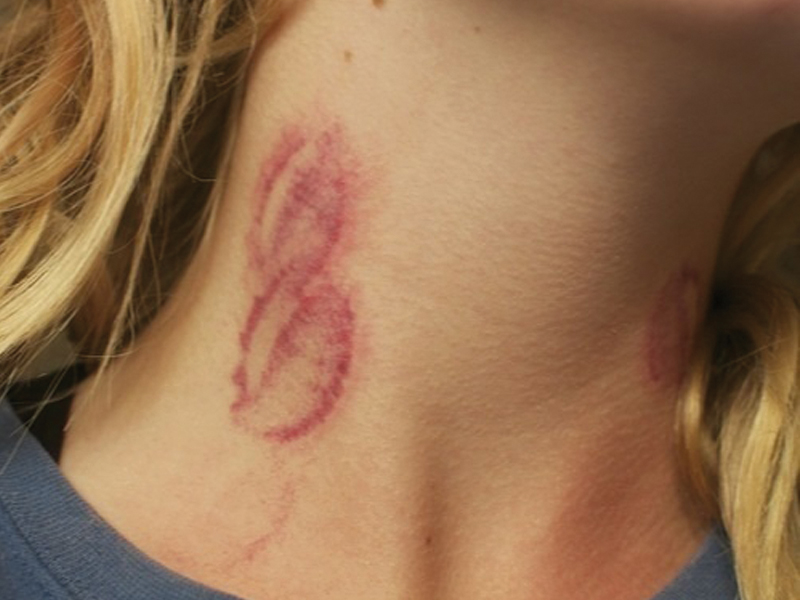
I don’t consider myself naive or anything, but if I see someone with a band-aid on their neck, my first thought would probably be they just got choked-slammed the night before. Some may question the need for any sort of neck cover-up, whether it is a scarf in the middle of the Riverside summer or a blotch of concealer right above the polo collar. But when the person in question responds with a coy smile and wide eyes, many would come to the only conclusion: a hickey. The purple traces of the fun night are almost like a car crash — you want to look away but can’t help but stare. Responses vary, usually, from a rolling of the eyes to a thumbs-up. But at what age do these responses change, or do they ever? What are the roaming thoughts on the alleged “curling iron burn?” What happens when someone sees, receives and gives a hickey?
Now if a neck looks as if it was clawed at by Satan himself, it may be wise to advise a trip to the doctor as well as an evaluation on the rabid partner. However, some may like the reminder that they got down to business. Hickies usually start to appear when a simple smooch means that their “game is weak.” Many have viewed these marks as child’s play. Almost everyone says that it’s the teenagers who wear them as something to be proud of — literally a love badge.
Fourth-year Deztini Malik broke it down as “a sign of, like, ‘look at me, I’m growing up and made out with someone, whoo!” Maybe hickies map out their thrill? Dillinger Carson, third-year, opened up about his love bite journey, as he has received more hickies than given (a thought many like to think). He explained how when one is younger it’s all in fun “if you don’t end up looking like a damn leopard.” But once a certain age is reached, he, and others, begin to see it as immature and trashy. “My teacher once caught me with one and (we) just thought it was funny … now it is a bit embarrassing.”
A subconscious thought is that the love bites are embarrassing — isn’t that why most reach for the scarf to cover up? Or is it just a way to conceal something that is just meant for you and your partner? Besides the claim that hickies are tacky, others view it as another form of PDA. “What you do in the bedroom does not need to be shared with the rest of the world,” said second-year Amy Clark. Teeth marks almost erase the idea of privacy as the public can already gather what kind of night they must have had.
The theory of “marking your territory” has also arisen when hickies are sucked in places that can easily be seen. That’s why fourth-year and a fan of the sexy marks, Elyse Chui, advised to take tactical approaches when going in for the kill. “Aim lower” she suggested, as the closer to the back, the safer you are from public scrutiny. And, if need be, class it up with a scarf or makeup, because “at any age, don’t let it show.” Brittini Villanueva, second year, may take this approach as someone who “loves to give them,” but hates to see them in public. “It’s fun to do, but anyone over 18 should know better.”
What happens, however, if one sees someone who surpasses that invisible age cap? Just walking around the grocery store and then boom — someone shopping for Metamucil is sporting a new neck accessory. Or sitting in a classroom and in comes the professor greeting everyone with sugar while their collar slips two inches too low? While some may say their 20s is the age cap for “visible” love bites, the age cap could be stretched all the way to 35. But I think it is universal: Seeing a 40-year-old with a hickey will most likely not get a thumbs-up but rather a body cringe with visuals.
All judgment aside, anything sexually related should be fun and agreed upon between everyone involved. For example, confirming with a partner if going all Edward Cullen on their neck is okay with them. Some say that their first hickey was more like a “what the fuck” kind of experience. It’s their second time that they make up their mind, if they like it or not … while looking up ways to remove it. Rennae Ybarra, fourth-year, has had this exact experience when she tried to dab makeup on it, only to make it look like a blotchy mess. Remedies for these bruises can range from the frozen spoon massage all the way to the tuna and oil treatment (literally leaving tuna on the mark for 10 minutes). Anything to push the blood vessels back into place have been attempted.
Even though a scarf in 100 degrees may be a dead giveaway to some, I’m sure students have seen more obscure things even just around campus. But the next time you see the mark on the neck, is it really from the seat belt? What do you think: to hickey or not to hickey?








